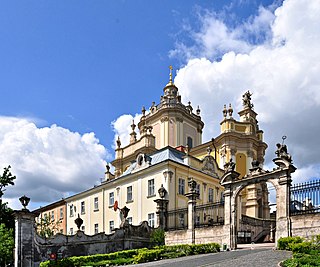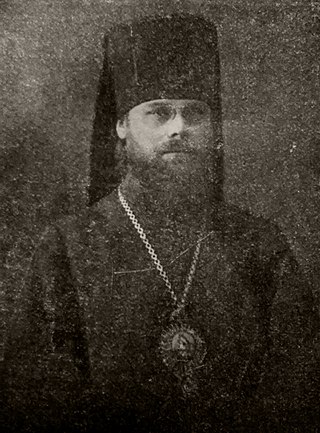This article has multiple issues. Please help improve it or discuss these issues on the talk page . (Learn how and when to remove these template messages)
|


Metropolitan Dionysius (born Konstantin Nikolayevich Valedinsky 4 May/16 May 1876 in Murom, Vladimir Governorate, Imperial Russia - 15 March 1960, Warsaw, Poland) was the Metropolitan of Warsaw and all Poland and the primate of the Polish Orthodox Church [1] from 27 February 1923 to 17 April 1948.
Konstantin was born in family of hereditary priests not far from Moscow in 1876. [2] He was a nephew of Arbishop Hieronim (Eksempliarsky) [3] who served as Archbishop of Warsaw (1898 — 1905) and Archbishop of Wilno (1894 — 1898). Konstantin lost his father early when he was only 12. [4] In 1897 Konstantin Valedinsky graduated a theological seminary in Ufa. [2] Already as a student of the Kazan Theological Academy during his first year of study he was tonsured as a monk with the name of Dionysius (Dionisios [4] ) and during the same year was consecrated as a deacon. [2] In 1899 Dionysius (Valedinsky) became hieromonk and was consecrated by Antony (Khrapovitsky) as a priest (iereus). [2] He graduated the academy in 1900 as a magister in theology. [2] (candidate of theology [4] ) His graduating dissertation was "Ideals of Orthodox-Russian foreign missionary work". [4] Due to his poor health Dionysius was not able to become a missionary. [4] In 1901-02 Dionysius was teaching a history of the Church in the Taurida Theological Seminary in Simferopol. [2]
On 22 December 1902 Dionysius was promoted to archimandrite and in 1902 to 1911 acted as a rector at the Chelm Theological Seminary. [2] In 1911-13 he was a priest of the Russian-Polish Church in Rome, [2] according to other sources, an Eastern Orthodox Church at the Russian Embassy in Rome. [4]
On 21 April 1913 Dionysius was ordained as a vicar bishop of Kremenets of the Volhynian Eparchy. [2] The ceremony took place at the Holy Dormition Pochaiv Lavra and was attended by Patriarch Gregory VII of Antioch [2] (Patriarch Gregory IV of Antioch??). In 1917 Dionysius participated in the All-Russian Local Council representing monks of the Volhynian Eparchy. [4]
During the World War I, Bishop Dionysius (Valedinsky) stayed in Kyiv and in 1918 participated in the All-Ukrainian Orthodox Church Assembly, [2] at which represented the eparchy of Polesie as diocesan bishop. [4] In 1919 he returned to Kremenets. [2] Following the Treaty of Riga, on 1 July 1921 bishop of Kremenets Dionysius was confirmed by the Polish authorities as a bishop of Kremenets and Volhynia [4] and in 1922 became archbishop. [2] In 1918-20 he also ruled over eparchies of Chelm, Lublin and others. [4]
Following the tragic assassination of Metropolitan of Warsaw George (Yaroshevsky), on 27 February 1923 he was elected as a Metropolitan of Warsaw and Chelm, [4] First Hierarch [4] of the Orthodox Church of Poland by the Bishop Council of the Orthodox Church in Poland. [2] On 13 March 1923 Ecumenical Patriarch Meletius IV of Constantinople confirmed Dionysius as the Metropolitan of Warsaw, Volhynia and All Poland and the Sacred Archimandrite of the Holy Dormition Pochaiv Lavra. [2] The Russian Orthodox Church considers it as "non-canonical". [2] His enthronization took place in Kremenets on 23 April 1923. [4] In response to Metropolitan Dionysius’ request to Patriarch Tikhon of Moscow to bless the independent existence of the Orthodox Church in the Polish state, the Patriarch refused to do this, expressing disagreement with this act and stating, in particular, that only the Local Council of the All-Russian Orthodox Church had the right to make such a decision. [2]
On 13 November 1924 the Ecumenical Patriarch Gregory VII of Constantinople signed the Patriarchal and Synodal Tomos granting autocephaly to the Polish Orthodox Church, and on September 17, 1925, an official ceremony of its proclamation took place in the Warsaw Metropolitan Cathedral of the Holy and Equal-to-the-Apostles Mary Magdalene. [2] In 1927, Metropolitan Dionysius received the title “His Beatitude” from the Ecumenical Patriarch Basil III of Constantinople. [2]
With start of the World War II, in 1939 Metropolitan Dionysius called the Eastern Orthodox citizens of Poland to fight invaders, for which he was placed under a "house arrest" [2] by Gestapo. [4] Following partition of Poland by Nazi Germany and Soviet Union, the Polish Orthodox Church lost most of its territories to the Russian Orthodox Church and few remaining came under administration of the Bishop of Berlin of the Russian Orthodox Church Outside of Russia. [2]
On 23 September 1940, Metropolitan Dionisius signed a loyalty declaration for the General Governor of Poland Hans Frank and was released from his arrest. [2] On 30 September 1940 the Bishop Council of the Polish Orthodox Church led by Metropolitan Dionisius reformed the Church considering the new realities and constituted new dioceses which were 3: Diocese of Warschau and Radom, Diocese of Cholm and Podlachia, Diocese of Krakau and Lemkos. [2]












